Closing the Register
The register close process can be performed by store managers or associates who have the proper security privileges. A register close can be completed any time during the day.
This process is highly configurable, and your process may be different than the instructions below. Every effort has been made to include notes or examples of additional steps that may be configured for your store.
The procedures described in this section assume that till accountability is not being used (this is a configurable option). For more information on till accountability and its requirements see the chapter, Till Management.
The register closing process depends upon whether your system is configured for standard opening and closing, or 24/7 trading:
-
Standard Close close process.
-
24/7 Store Environment trading close process.
-
Cash Drawer Close close process.
Standard Close
Note:
The open/close instructions below include the counting of tills to show all steps to close the register. Refer to the Till Options chapter in the Oracle Retail Xstore Point of Service Classic User Guide for more information.
-
From the register to be closed, select the Back Office option on the menu. Follow any prompts to log in to the Back Office as required.
-
At the Till menu, use the up and down arrow keys to select Open/Close Options and press Enter, or press the number associated with the menu option on the keyboard.
Figure 8-2 Till Menu - Open/Close Options
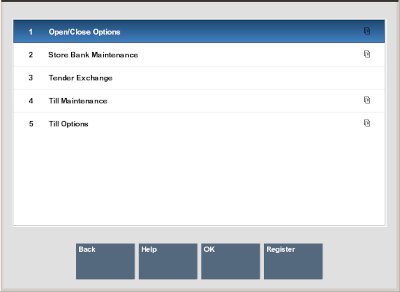
-
Xstore Classic displays the Open/ Close Options menu. Select the Register Close option and press Enter, or press the number associated with the menu option on the keyboard.
Figure 8-3 Register Close Option

Note:
Note that the Register option toggles between open and close. If the option is Register Close, the register is currently open. If the option is Register Open, the register is currently closed.
-
Oracle Retail Xstore Point of Service displays a confirmation prompt: Do you want to close this register? Press Yes to close the register.
Note:
Pressing No at the Register Close confirmation prompt cancels the register close process and returns you to the Open/Close Options menu.
-
The cash drawer opens, and Xstore Classic displays the Close Count Summary screen. Each count group (tender type) is counted individually. Specific groups require additional information as determined by the home office. Select the tender type to be counted and then select the Count Selected option to display the tender group's count screen.
Figure 8-4 Close Count Summary Screen
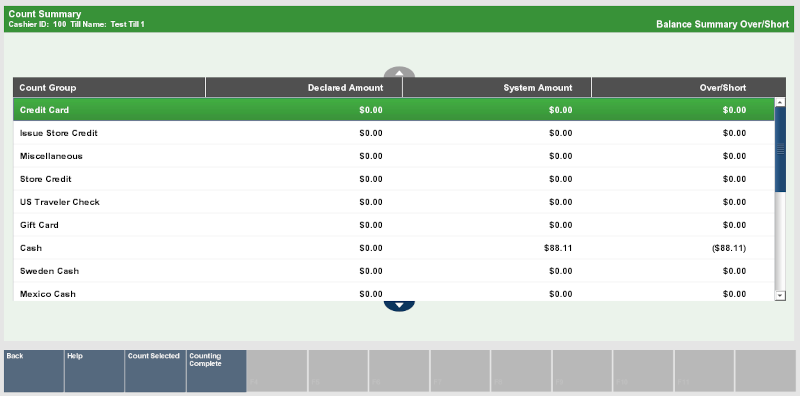
Note:
Depending upon the configuration of your system and your store policy, the over/short amounts as shown above may not be displayed.
-
Enter each value as required in the focus bar and press Enter. The tender type you select, and your system's configuration determine the type of count you must perform. The following table shows Xstore Classic base examples.
Table 8-1 Tender Count Screen Xstore Base Examples - Standard
Tender Count Example Credit Card
(Totals Count)
The focus bar prompts to enter the Count and then the Amount.
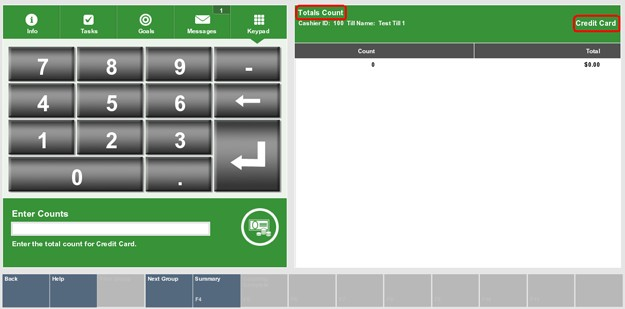
Cash (Denomination Count)
The focus bar prompts to enter the Count for each denomination. In the example below, the Fifty dollar denomination is being counted. Once Enter is pressed, the system highlights the next denomination in the count. The amount is calculated based on the quantity entered and displays a running total at the bottom of the screen.
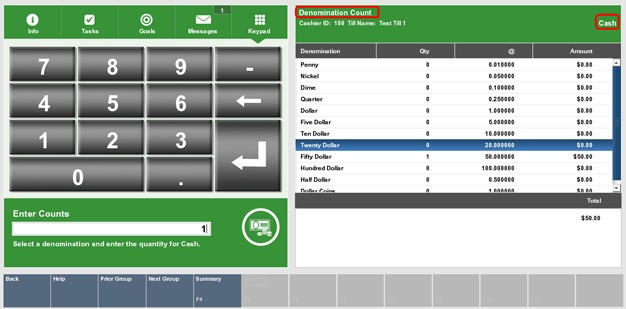
Check (Totals Count)
The focus bar prompts to enter the Serial # and then the Amount. The system calculates the amount based on the quantity entered and displays a running total at the bottom of the screen.

Note:
A Totals Count prompts for a total number of the tender type and the total amount.
A Denomination Count requires that you specify the number of items (Count) and the value of each item in the tender group (Amount) that you selected.
Note:
The type of count is labeled on the upper left portion of the count screen view port. The tender type is identified in the upper right portion of the count screen view port.
-
Select Next Group to display the next count screen.
Note:
Select Prior Group to go back to the previous count screen.
-
Repeat steps 6-7 until all tenders are counted. Select Summary to return to the Count Summary screen.
-
Review the amounts. If the totals are correct, select the Counting Complete button.
Note:
Check the Over/Short column to see if your till is balanced with the system values for each tender type. To modify counts see Editing Tender Group Counts.
If the till is in balance, a confirmation message displays. Press Enter to continue the register close.
Figure 8-5 Till in Balance

-
If any tenders are out of balance-your counts do not match the system expected amounts, Xstore Classic displays a list of tenders that are out of balance.
Figure 8-6 Tenders Out of Balance Prompt
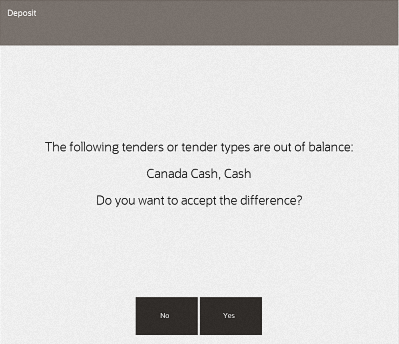
-
Select Yes to accept your counted amounts. If prompted, select a reason for the count discrepancy and/or type a comment about the discrepancy.
<OR>
-
Select No to recount any tenders as needed. Xstore Classics re-displays the Close Count screen where you can make your changes as needed. See Editing Tender Group Counts.
-
-
Depending upon your system's configuration, you may be prompted with the suggested deposit amount.
-
Select Accept Deposit to confirm the amount to be deposited and go to step 12.
-
Select Change Deposit to enter an amount to be deposited:
-
You are prompted to enter the amount to be deposited. Enter the amount and press Enter to continue the register close.
Note:
You can select the Deposit Calculator option to display a denomination count screen that can be used as a calculator-showing a running total at the bottom of the screen as you count the cash amount to be deposited.
-
-
-
The system may be configured to print a Closed Count receipt and a Register Closed receipt.
Close the cash drawer and the system closes the register.
Editing Tender Group Counts
If a tender group is out of balance, you can recount an individual tender group and edit the original count you entered in to the system.
-
At the Count Summary screen (Figure 8-4), select the tender group that must be recounted and select the Count Selected option to display the tender group count screen.
-
Recount the tender and enter the new count values. Most tenders allow you to override the denomination count by selecting the row and then adding values into the focus bar prompts. When you press Enter the count value changes. For checks, however, you must select the Remove Count button to delete the row and then re- enter the Serial # and Amount.
Figure 8-7 Remove Count Option
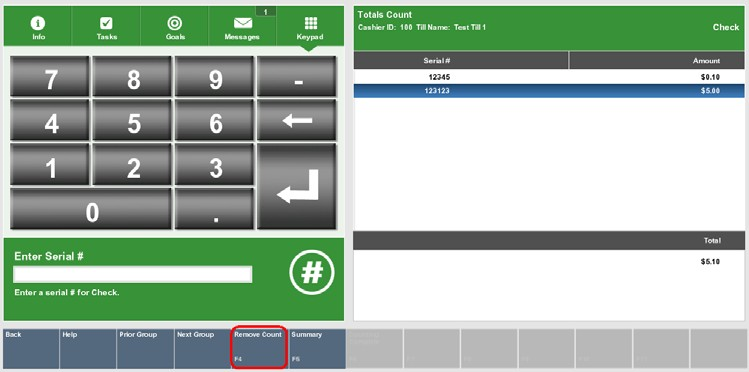
-
Select the Summary option to view the changes and return to the Tender Group Summary screen.
-
Repeat steps 1-3 for each tender group that is not balanced. When you have completed editing the tender groups, select the Counting Complete option. If there are tender groups that are still out of balance, a screen displays prompting whether you want to recount the tenders or accept the count and continue with the register close process.
-
Depending upon your system's configuration, you may be prompted with the suggested deposit amount. See step 10 to complete the register close process.
Cash Drawer Close
If your system is configured to use networked cash drawers, closing the register is done by closing the cash drawer.
You must remove the till before closing the cash drawer. See Removing a Cash Drawer Till for more information.
To close the cash drawer:
-
In the Back Office menu, select Open/Close Options.
Figure 8-8 Open/Close Options - Register Close

-
Select Cash Drawer Close. A list of open cash drawers displays.
-
Select the drawer to close.
-
Select OK. A confirmation prompt opens.
-
Select Yes.
-
The physical cash drawer opens, and Oracle Retail Xstore Point of Service displays the Close Count Summary screen. Each count group (tender type) is counted individually. Specific groups require additional information as determined by the home office. Select the tender type to be counted and then select the Count Selected option to display the tender group's count screen.
Figure 8-9 Close Count Summary Screen

Note:
Depending upon the configuration of your system and your store policy, the over/short amounts as shown above may not be displayed.
-
Enter each value as required in the focus bar and press Enter. The tender type you select, and your system's configuration determine the type of count you must perform. The following table shows Xstore base examples.
Table 8-2 Tender Count Screen Xstore Base Examples - Cash Drawer
Tender Count Example Credit Card
(Totals Count)
The focus bar prompts to enter the Count and then the Amount.

Cash (Denomination Count)
The focus bar prompts to enter the Count for each denomination. In the example below, the Fifty dollar denomination is being counted. Once Enter is pressed, the system highlights the next denomination in the count. The amount is calculated based on the quantity entered and displays a running total at the bottom of the screen.

Check (Totals Count)
The focus bar prompts to enter the Serial # and then the Amount. The system calculates the amount based on the quantity entered and displays a running total at the bottom of the screen.

Note:
A Totals Count prompts for a total number of the tender type and the total amount.
A Denomination Count requires that you specify the number of items (Count) and the value of each item in the tender group (Amount) that you selected.
Note:
The type of count is labeled on the upper left portion of the count screen view port. The tender type is identified in the upper right portion of the count screen view port.
-
Select Next Group to display the next count screen.
Note:
Select Prior Group to go back to the previous count screen.
-
Repeat steps 6-7 until all tenders are counted. Select Summary to return to the Count Summary screen.
-
Review the amounts. If the totals are correct, select the Counting Complete button.
Note:
Check the Over/Short column to see if your till is balanced with the system values for each tender type. To modify counts see Editing Tender Group Counts.
If the till is in balance, a confirmation message displays. Press Enter to continue the cash drawer close.
Figure 8-10 Till in Balance

-
If any tenders are out of balance-your counts do not match the system expected amounts-Xstore displays a list of tenders that are out of balance.
Figure 8-11 Tenders Out of Balance Prompt

-
Select Yes to accept your counted amounts. If prompted, select a reason for the count discrepancy and/or type a comment about the discrepancy.
<OR>
-
Select No to recount any tenders as needed. Oracle Retail Xstore Point of Service re-displays the Close Count screen where you can make your changes as needed. See Editing Tender Group Counts.
-
-
Depending upon your system's configuration, you may be prompted with the suggested deposit amount.
-
Select Accept Deposit to confirm the amount to be deposited and go to step 12.
-
Select Change Deposit to enter an amount to be deposited:
-
You are prompted to enter the amount to be deposited.
-
Enter the amount and press Enter to continue the cash drawer close.
Note:
You can select the Deposit Calculator option to display a denomination count screen that can be used as a calculator-showing a running total at the bottom of the screen as you count the cash amount to be deposited.
-
-
-
The system may be configured to print a Closed Count receipt and a Cash Drawer Closed receipt.
Figure 8-12 End Count Deposit Receipt Sample
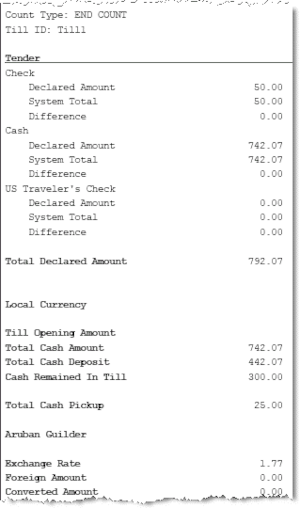
Figure 8-13 Close Receipt Sample

-
Close the physical cash drawer to complete the close process. This register is now closed as indicated by the Register indicator color change (from green to red).
Figure 8-14 Back Office View - Register Closed

Note:
If configured, you can still access functions that do not require a till such as Clock In and Clock Out, Item Lookup, and View Timecard even though the register is closed for sale transactions.